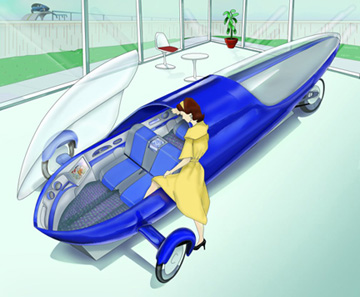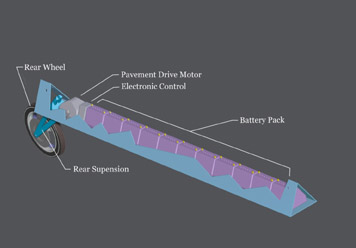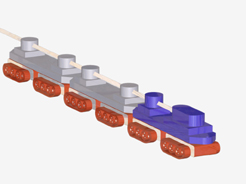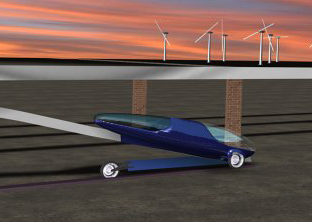TriTrack Dualmode Concept
by Jerry Roane
Austin, Texas
 TriTrack is a dualmode system concept. A patent is pending.
It is similar to the RUF system in that the car swallows the track. The TriTrack
would travel at 180 miles per hour and would be implemented in a straight grid pattern
over an entire populated area. The tracks would be on a half-mile grid and they are
very inexpensive to build - in the range of $29.00 per foot. The track is built at 3
mph on existing right of way. It occupies the volume where cable TV goes now.
TriTrack is a dualmode system concept. A patent is pending.
It is similar to the RUF system in that the car swallows the track. The TriTrack
would travel at 180 miles per hour and would be implemented in a straight grid pattern
over an entire populated area. The tracks would be on a half-mile grid and they are
very inexpensive to build - in the range of $29.00 per foot. The track is built at 3
mph on existing right of way. It occupies the volume where cable TV goes now.
The track has a small hollow center where cable and power lines would be routed to clean
up the skyline of cities. The car has a drag coefficient of .09 which is much better
than any of the transportation proposals I have seen. The patent was filed a few
months ago even though the development of the electric car has been going on for 20 plus
years. The car leaves its battery pack on the ground when it goes up on the rail.
The battery packs would be owned by the power company but the car still would
belong to the rider. That way all of the advantages of a personal car are maintained
but the advantages of the electrification of ground transportation are gained.
TriTrack would have a big impact on our dependence on foreign oil and the quality of the
air we all have to breathe.
This vehicle is very light weight. It has no frame but rather the outer shell is
the structure. The TriTrack is road worthy as a surface street vehicle. Actually the
design of the electric car has been going on for more than 20 years but more recently the
car has been adapted to be a dual mode (modal) monorail.
I am currently working with the University of Texas at Austin UT-CEM to get funding
from the state of Texas to go through the University research program to study the details
of the system. They have the linear motor technology ready to go already, and the
engineering studies of the battery transaction at 40 MPH and the air hockey function of
the track will be studied with the University's wind tunnel and labs.
 The first composite car body is built and is in
development but not to a demonstration stage yet. The first demonstration track is
hopefully going to be between the UT main campus and the J. J. Pickle research facility in
North Austin. This track would provide an excellent opportunity to showcase the
environmental aspects of this concept. The area under the track would be restored to
its original natural beauty. Austin is built in the Texas hill country and this
river valley was a jewel in what is generally a flat and boring state. The city has
trampled the natural setting and putting in the TriTrack will afford an opportunity to
restore the land under the tracks to a more natural state. I envision ribbons of
park land under these tracks that will crisscross the concrete city with bike trails and
walk able green spaces.
The first composite car body is built and is in
development but not to a demonstration stage yet. The first demonstration track is
hopefully going to be between the UT main campus and the J. J. Pickle research facility in
North Austin. This track would provide an excellent opportunity to showcase the
environmental aspects of this concept. The area under the track would be restored to
its original natural beauty. Austin is built in the Texas hill country and this
river valley was a jewel in what is generally a flat and boring state. The city has
trampled the natural setting and putting in the TriTrack will afford an opportunity to
restore the land under the tracks to a more natural state. I envision ribbons of
park land under these tracks that will crisscross the concrete city with bike trails and
walk able green spaces.
 The heavy part of the car (i.e. the battery pack or mule) stays
behind when you go up on the track. There is no reason to haul that part of the
vehicle around at 180 miles per hour. Almost all of the vehicles that I have seen
have horrible aerodynamic properties. A rectangular flat plate is a textbook example
of a poor aerodynamic shape. The aerodynamic drag coefficient is .09. The
frontal area is a linear multiplier to aero drag and must be considered if we are to end
our dependence on foreign oil..
The heavy part of the car (i.e. the battery pack or mule) stays
behind when you go up on the track. There is no reason to haul that part of the
vehicle around at 180 miles per hour. Almost all of the vehicles that I have seen
have horrible aerodynamic properties. A rectangular flat plate is a textbook example
of a poor aerodynamic shape. The aerodynamic drag coefficient is .09. The
frontal area is a linear multiplier to aero drag and must be considered if we are to end
our dependence on foreign oil..
I can lift the four seater car body shell over my head yet it is very stiff and because
its strength is on the outer shell it is resistant to damage. I address the
collision problem with a fundamental shift in thinking. What if cars don't run into
each other? There are many features of the TriTrack that make that conceivable that
are mentioned in the patent application. I contend that if we use the available
computer technology there is no reason in 2003 that cars should run into each other.
The surface street travel will be at a non-lethal speed. The maximum travel
distance at this slower non-lethal speed will be 1/4 mile. After that you will be on
the safe grid going 180 mph. This non-lethal speed will be lowered until people quit
dying on America's streets. I anticipate that 40 mph will be close to that speed.
Because the mule (i.e. battery pack) is owned by the electric company or municipality
the speed will actually be controlled. (even down hills). The traffic congestion
will be solved because of the tremendous capacity of the system so the likelihood of a
collision will be lessoned on the surface streets. Each single track can carry 9,000
people per hour. The tracks are in groups of 4 or 5. A North South/ East West grid
of about 30 groups would cover a city the size of Austin.
I believe that some version of a dual mode transportation system is the only free market
viable solution. You can only brow beat people so much into large trains and walking
in the heat and rain. It is ultimately the performance of the system that will
determine its value. Conventional wisdom says that you have to trade in convenience
and cost for lowering air pollution. I contend that if you approach transportation
from an energy waste reduction standpoint that you can have it all.
TriTrack would produce very low emissions and would allow a transformation from oil based
fuels to any of a wide variety of clean energy sources. It is an apparatus that is shared
between the power company and the commuter and would level out the day's peak power curve.
If we are eventually going to use solar and wind as a valid energy source there
will need to be a tremendously huge energy storage system built. The TriTrack
battery packs distributed all over the populated area would provide that much capacity.
Many companies would be involved in producing the parts and services. The TriTrack
will be structured as an open architecture system. Each component of the system
would be built by the same people who build cars now except the modules will be defined
from the outside and each company will need to compete on a module basis. This open
architecture concept has been the driving force behind the personal computer's phenomenal
success. TriTrack is a simpler vehicle than current cars and easier to build.
The cost per mile of trackway is drastically lower. One track has the capability to
move 9,000 people per hour. The tracks would be in groups of 4 rails providing an
excess of capacity for another generation or two.
 The track is extruded in place and to shape at 3 miles
per hour. This would enable an areawide implementation rather than a mile here and a
mile there. The value of the system is when you can go all the way from point
A to point B. A typical trip would start in your own garage in your own TriTrack
car. The cost of these cars should be around $6000.00. The battery pack that
is under the car is borrowed from the electric company for the night. You leave your
driveway and travel on the surface streets at a non-lethal speed (fundamental to the
system is the non-lethality of the system)) to the start of a track. There is no
station.
The track is extruded in place and to shape at 3 miles
per hour. This would enable an areawide implementation rather than a mile here and a
mile there. The value of the system is when you can go all the way from point
A to point B. A typical trip would start in your own garage in your own TriTrack
car. The cost of these cars should be around $6000.00. The battery pack that
is under the car is borrowed from the electric company for the night. You leave your
driveway and travel on the surface streets at a non-lethal speed (fundamental to the
system is the non-lethality of the system)) to the start of a track. There is no
station.
 You head towards the start of the track much like going
to a car wash. The car goes up on the track and as it leaves the ground it leaves
the heavy battery pack and rear wheel behind to be recharged in a charging queue.
The up ramp of the track has a linear motor that accelerates the car to 180 mph from 40
mph. The car maintains its speed with a much smaller internal motor inside the
body. Once the car gets to the exit ramp a linear generator reclaims the energy that
was placed in the momentum of the car and that energy is returned to the power grid and to
the local battery charging queue. The pulse of power is filtered by the local
battery packs. At the end of the off-ramp, a battery pack is attached to support
travel on the conventional roadway system.
You head towards the start of the track much like going
to a car wash. The car goes up on the track and as it leaves the ground it leaves
the heavy battery pack and rear wheel behind to be recharged in a charging queue.
The up ramp of the track has a linear motor that accelerates the car to 180 mph from 40
mph. The car maintains its speed with a much smaller internal motor inside the
body. Once the car gets to the exit ramp a linear generator reclaims the energy that
was placed in the momentum of the car and that energy is returned to the power grid and to
the local battery charging queue. The pulse of power is filtered by the local
battery packs. At the end of the off-ramp, a battery pack is attached to support
travel on the conventional roadway system.
 A typical trip would have four legs. The first
leg would be on the surface streets. For the second leg you might go as far North as
you wished and then you would come down off the track and mount an Eastbound track for the
third leg. The fourth leg would involve a trip of less than 1/4 mile using surface streets
to get to the door of your destination. Because the cars are lightweight
without their battery packs the cars would actually park themselves on the roof on their
tails. This would eliminate a tremendous amount of parking space required for
cities today and would allow for garage space to become more profitable office
space. The postive real estate space-saving effects of this concept would alone
would pay for the system.
A typical trip would have four legs. The first
leg would be on the surface streets. For the second leg you might go as far North as
you wished and then you would come down off the track and mount an Eastbound track for the
third leg. The fourth leg would involve a trip of less than 1/4 mile using surface streets
to get to the door of your destination. Because the cars are lightweight
without their battery packs the cars would actually park themselves on the roof on their
tails. This would eliminate a tremendous amount of parking space required for
cities today and would allow for garage space to become more profitable office
space. The postive real estate space-saving effects of this concept would alone
would pay for the system.
You can view a newscast about the TriTrack on www.kxan.com,
search for monorail. Click on the story about congestion. Click on
"Monorail Car" and it will play the 3 minute newscast if you have Real One
player.
For the latest developments on TriTrack, see the official TriTrack
website. It includes a FAQ page and several animations.. Or contact the
inventor at: JRoane@Austin.rr.com,
phone: 512-263-5344.

Last modified: August 25, 2006
 TriTrack is a dualmode system concept. A patent is pending.
It is similar to the RUF system in that the car swallows the track. The TriTrack
would travel at 180 miles per hour and would be implemented in a straight grid pattern
over an entire populated area. The tracks would be on a half-mile grid and they are
very inexpensive to build - in the range of $29.00 per foot. The track is built at 3
mph on existing right of way. It occupies the volume where cable TV goes now.
TriTrack is a dualmode system concept. A patent is pending.
It is similar to the RUF system in that the car swallows the track. The TriTrack
would travel at 180 miles per hour and would be implemented in a straight grid pattern
over an entire populated area. The tracks would be on a half-mile grid and they are
very inexpensive to build - in the range of $29.00 per foot. The track is built at 3
mph on existing right of way. It occupies the volume where cable TV goes now.  The first composite car body is built and is in
development but not to a demonstration stage yet. The first demonstration track is
hopefully going to be between the UT main campus and the J. J. Pickle research facility in
North Austin. This track would provide an excellent opportunity to showcase the
environmental aspects of this concept. The area under the track would be restored to
its original natural beauty. Austin is built in the Texas hill country and this
river valley was a jewel in what is generally a flat and boring state. The city has
trampled the natural setting and putting in the TriTrack will afford an opportunity to
restore the land under the tracks to a more natural state. I envision ribbons of
park land under these tracks that will crisscross the concrete city with bike trails and
walk able green spaces.
The first composite car body is built and is in
development but not to a demonstration stage yet. The first demonstration track is
hopefully going to be between the UT main campus and the J. J. Pickle research facility in
North Austin. This track would provide an excellent opportunity to showcase the
environmental aspects of this concept. The area under the track would be restored to
its original natural beauty. Austin is built in the Texas hill country and this
river valley was a jewel in what is generally a flat and boring state. The city has
trampled the natural setting and putting in the TriTrack will afford an opportunity to
restore the land under the tracks to a more natural state. I envision ribbons of
park land under these tracks that will crisscross the concrete city with bike trails and
walk able green spaces.  The heavy part of the car (i.e. the battery pack or mule) stays
behind when you go up on the track. There is no reason to haul that part of the
vehicle around at 180 miles per hour. Almost all of the vehicles that I have seen
have horrible aerodynamic properties. A rectangular flat plate is a textbook example
of a poor aerodynamic shape. The aerodynamic drag coefficient is .09. The
frontal area is a linear multiplier to aero drag and must be considered if we are to end
our dependence on foreign oil..
The heavy part of the car (i.e. the battery pack or mule) stays
behind when you go up on the track. There is no reason to haul that part of the
vehicle around at 180 miles per hour. Almost all of the vehicles that I have seen
have horrible aerodynamic properties. A rectangular flat plate is a textbook example
of a poor aerodynamic shape. The aerodynamic drag coefficient is .09. The
frontal area is a linear multiplier to aero drag and must be considered if we are to end
our dependence on foreign oil..  The track is extruded in place and to shape at 3 miles
per hour. This would enable an areawide implementation rather than a mile here and a
mile there. The value of the system is when you can go all the way from point
A to point B. A typical trip would start in your own garage in your own TriTrack
car. The cost of these cars should be around $6000.00. The battery pack that
is under the car is borrowed from the electric company for the night. You leave your
driveway and travel on the surface streets at a non-lethal speed (fundamental to the
system is the non-lethality of the system)) to the start of a track. There is no
station.
The track is extruded in place and to shape at 3 miles
per hour. This would enable an areawide implementation rather than a mile here and a
mile there. The value of the system is when you can go all the way from point
A to point B. A typical trip would start in your own garage in your own TriTrack
car. The cost of these cars should be around $6000.00. The battery pack that
is under the car is borrowed from the electric company for the night. You leave your
driveway and travel on the surface streets at a non-lethal speed (fundamental to the
system is the non-lethality of the system)) to the start of a track. There is no
station.  You head towards the start of the track much like going
to a car wash. The car goes up on the track and as it leaves the ground it leaves
the heavy battery pack and rear wheel behind to be recharged in a charging queue.
The up ramp of the track has a linear motor that accelerates the car to 180 mph from 40
mph. The car maintains its speed with a much smaller internal motor inside the
body. Once the car gets to the exit ramp a linear generator reclaims the energy that
was placed in the momentum of the car and that energy is returned to the power grid and to
the local battery charging queue. The pulse of power is filtered by the local
battery packs. At the end of the off-ramp, a battery pack is attached to support
travel on the conventional roadway system.
You head towards the start of the track much like going
to a car wash. The car goes up on the track and as it leaves the ground it leaves
the heavy battery pack and rear wheel behind to be recharged in a charging queue.
The up ramp of the track has a linear motor that accelerates the car to 180 mph from 40
mph. The car maintains its speed with a much smaller internal motor inside the
body. Once the car gets to the exit ramp a linear generator reclaims the energy that
was placed in the momentum of the car and that energy is returned to the power grid and to
the local battery charging queue. The pulse of power is filtered by the local
battery packs. At the end of the off-ramp, a battery pack is attached to support
travel on the conventional roadway system. A typical trip would have four legs. The first
leg would be on the surface streets. For the second leg you might go as far North as
you wished and then you would come down off the track and mount an Eastbound track for the
third leg. The fourth leg would involve a trip of less than 1/4 mile using surface streets
to get to the door of your destination. Because the cars are lightweight
without their battery packs the cars would actually park themselves on the roof on their
tails. This would eliminate a tremendous amount of parking space required for
cities today and would allow for garage space to become more profitable office
space. The postive real estate space-saving effects of this concept would alone
would pay for the system.
A typical trip would have four legs. The first
leg would be on the surface streets. For the second leg you might go as far North as
you wished and then you would come down off the track and mount an Eastbound track for the
third leg. The fourth leg would involve a trip of less than 1/4 mile using surface streets
to get to the door of your destination. Because the cars are lightweight
without their battery packs the cars would actually park themselves on the roof on their
tails. This would eliminate a tremendous amount of parking space required for
cities today and would allow for garage space to become more profitable office
space. The postive real estate space-saving effects of this concept would alone
would pay for the system.